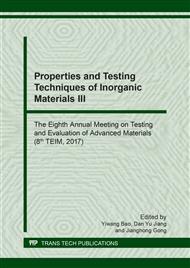[1]
T.B. Zhu, Y.W. Li, S.B. Sang, Z.P. Xie, Mechanical behavior and thermal shock resistance of MgO-C refractories:Influence of graphite content, Ceram. Int. 43 (2017) 7177-7183.
DOI: 10.1016/j.ceramint.2017.03.004
Google Scholar
[2]
S. Ghasemi-Kahrizsangi, H.G. Dehsheikh, M. Boroujerdnia, Effect of micro and nano-Al2O3 addition on the microstructure andproperties of MgO-C refractory ceramic composite, Mater. Chem. Phys. 189 (2017) 230-236.
DOI: 10.1016/j.matchemphys.2016.12.068
Google Scholar
[3]
S. Behera, R. Sarkar, Effect of different metal powder anti-oxidants on N220 nano carboncontaining low carbon MgO-C refractory: An in-depth investigation, Ceram. Int. 42 (2016) 18484-18494.
DOI: 10.1016/j.ceramint.2016.08.185
Google Scholar
[4]
W. Yuan, Q.Zhu, C. Deng, H. Zhu, The influence of TiO2 addition on the modulus of rupture of alumina-magnesia refractory castables, J. Mater. Eng. Perform. 24 (2015) 3100-3106.
DOI: 10.1007/s11665-015-1600-4
Google Scholar
[5]
T.B. Zhu, Y.W. Li, S.B. Sang, Z.P. Xie, Fracture behavior of low carbon MgO-C refractories using the wedge splitting test, J. Eur. Ceram. Soc. 37 (2017) 1789-1797.
DOI: 10.1016/j.jeurceramsoc.2016.11.013
Google Scholar
[6]
W. Yuan, Q. Zhu, C. Deng, H. Zhu, Fractal analysis of fracture surfaces in refractories, Chin. Refract.23 (1) (2014) 27-31.
Google Scholar
[7]
J.J. Mecholsky, T.J. Mackin, D.E. Passoja, Self-similar crack propagation in brittle materials, Advances in Ceramics, Fractography of Glasses and Ceramics, Vol 22, J. Varner and V.D. Frechette, Ed., America Ceramic Society, Westerville, OH, 1988, pp.127-134.
Google Scholar
[8]
J.A. Rodrigues, V.C. Pandolfelli.Insights on the fractal-fracture behaviour relationship, Mater. Res.1 (1) (1998) 47-52.
Google Scholar
[9]
J.J. Mecholsky, D.E. Passoja, K.S Feinberg-Ringel, Quantitative analysis of brittle fracture surfaces using fractal geometry, J. Am. Ceram. Soc. 72 (1989) 60-65.
DOI: 10.1111/j.1151-2916.1989.tb05954.x
Google Scholar
[10]
W. Yuan, Q. Zhu, C. Deng, H. Zhu, The effect of the glass phase on modulus of rupture of high alumina refractories, J. Ceram. Sci. Technol. 6 (2015) 215-220.
Google Scholar
[11]
C.A. Schacht, Refractories Handbook, Marcel Dekker, Inc., New York,2004, p.17.
Google Scholar
[12]
L. Shi, H.Y. Li, Z.M. Zou, A.S.L. Fok, B.J. Marsden, A. Hodgkins, P.M. Mummery, J. Marrow, Analysis of crack propagation in nuclear graphite using three-point bending of sandwiched specimens, J. Nucl. Mater. 372 (2-3) (2008) 141-151.
DOI: 10.1016/j.jnucmat.2007.02.012
Google Scholar


